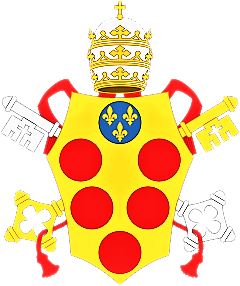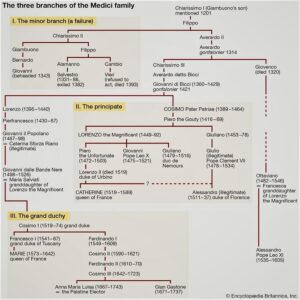The Medici Family (Founded in 1230 – Dissolved in 1743) were a powerful and influential family of the Renaissance in Florence, Founded by Giambuono de’ Medici.
Whose members included four popes: Leo X, Pius IV, Clement VII, and Leo XI; two queens of France: Marie de Medici and Catherine de Medici; and numerous Florentine leaders, members of the royal houses of France and England, who stood out as patrons, sponsoring artists and scientists of their time.
The Medici acquired their wealth in the textile trade, which was operated by the Guild Arte Della Lana. On this basis, they founded a modern banking system and dominated the European financial world of the early modern period – also through their relationships with the papacy.

Facts About Medici Family
- Founded: 1230; 791 years ago
- Founder: Giambuono de’ Medici
- Place of Origin: Mugello, Tuscia (present-day Tuscany)
- Country:
Republic of Florence
Grand Duchy of Tuscany
Papal States
Duchy of Urbino - Members:
Giovanni di Bicci de’ Medici
Cosimo de’ Medici
Lorenzo de’ Medici
Pope Leo X
Pope Clement VII
Pope Leo XI
Catherine de’ Medici
Cosimo I de’ Medici
Marie de’ Medici - Religion: Roman Catholicism
- Motto: (“Make haste slowly”)
- Final Ruler: Gian Gastone de’ Medici
- Final Head: Anna Maria Luisa de’ Medici
- Dissolved: 1743
History of the Medici
The Medici family had up to ten bank branches: in Avignon, Venice, Rome, Naples, Milan, Pisa, Geneva, Lyon, Bruges, and London. In 1378, Salvestro de’ Medici proposed a reform widening the suffrage within the Republic, attracting the sympathy of the population for his family.
The elder branch descends from Piero di Cosimo de’ Medici and Lorenzo de’ Medici, his son, and ended with the murder of Alexander ” the Moor ” in 1537. Power then passed down to the younger branch of Laurent Old, then represented by Cosimo I Medici who came to power in 1537.
The branches form a clan of 32 families joining the 14th century to secretly enter the levers of power by posing as supporters of the people against the florentine oligarchy made up of wealthy trading families (Albizzi family, Alberti, Strozzi) at the head of the 7 Major Arts.
The male direct line of descent died out in 1737 (see genealogy below), but two younger branches remain, the Medici di Ottajano and the Medici Tornaquinci. The history of the House of Medici is certainly rich and complex, but its results must be qualified.
Art and Architecture
In the arts, the Medici were a dynasty adept at patronage and collecting; Anna Maria Luisa de’ Medici, the dowager voter of the Palatinate of the Rhine, last survivor of the house, bequeathed her collection to the city of Florence, on the condition that the treasures remain in the city, which transformed it into a “glory of the World ”, bringing together more than 50 museums.
In architecture, the Medici are responsible for several notable buildings in Florence, including the Uffizi Gallery, the Pitti Palace, the Boboli Gardens, the Belvedere, and the Medici Palace.
- The Basilica di San Lorenzo with the Medici chapels, including the New Sacristy with the funerary figures of Michelangelo
- The Cathedral of Santa Maria del Fiore, the largest church of its time, with which Cosimo de ‘Medici commissioned Brunelleschi and which could be completed in 1436,
- The Palazzo Medici Riccardi , begun in 1444, built by Michelozzo ,
- The Palazzo Pitti , which Eleonora de Toledo, Cosimo’s wife, acquired from Buonaccorso Pitti in 1550 ,
- The Uffizi, which Giorgio Vasari built on behalf of Cosimo I in 1560,
- The Accademia delle Arti del Disegno, founded in 1563 as Accademia e Compagnia dell’Arte del Disegno (which now preserves the original of Michelangelo’s “David”),
- The Boboli Gardens behind the Pitti Palace,
- The Belvedere,
- The Biblioteca Medicea Laurenziana.
Grand Dukes of Tuscany
The pro-French policy of Clement VII, which caused the sack of Rome by the Germans, led to the expulsion of the Medici from Florence in 1527. Then the pope who fled from Rome made an alliance with Charles V and with his help returned Florence to Alessandro. After a ten-month siege, Florence surrendered to German troops in 1530.
Alessandro Medici, married to Margarita, the bastard daughter of Charles V, received from him hereditary monarchical power in Florence with the title of duke. Duke Alessandro Medici caused widespread discontent with his debauchery. After unsuccessful complaints against him to Charles V, the disaffected organized a conspiracy.
Alessandro was killed by his relative, Lorenzino, in 1537. The assassin was forced to flee and was killed in Venice in 1548.

